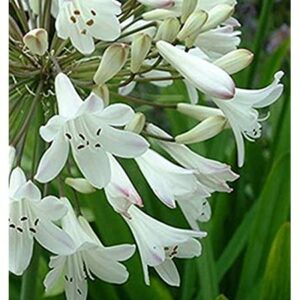Description
Garden Advice Notes
Sidalcea Brilliant, also known as the Brilliant Pink Prairie Mallow or Checker Mallow, is a perennial flowering plant native to western North America. It belongs to the mallow family and produces striking pink flowers that bloom from late spring to early summer.
The plant grows up to 3 feet tall and has an upright, bushy habit with green, lobed leaves that are slightly hairy. The flowers grow on long stems and have five petals that are a vibrant pink color. They are arranged in clusters that rise above the foliage and create a showy display.
It is drought-tolerant once established and attracts pollinators like bees and butterflies to its nectar-rich flowers.
In addition to being a beautiful addition to any garden, Sidalcea Brilliant is also a useful plant in traditional medicine. It has been used by Native Americans to treat various ailments such as stomachaches, sore throats, and skin irritations.
Soil type-Sidalcea Brilliant grows best in moist, well-drained soil that is rich in organic matter. It prefers a slightly acidic to neutral soil pH between 6.0 and 7.0. The plant can tolerate a wide range of soil types, including clay, loam, and sandy soils, as long as they are well-draining. However, it is important to avoid waterlogged soil, as this can lead to root rot and other diseases. To improve soil quality, you can add compost or other organic matter to the planting area before planting Sidalcea Brilliant.
Location-Sidalcea Brilliant is native to western North America and is adapted to a wide range of growing conditions. It grows best in full sun to partial shade and prefers a location with moderate temperatures and consistent moisture. In its natural habitat, it is often found in meadows, prairies, and open woodlands where there is ample sunlight and good soil drainage.
If you are growing Sidalcea Brilliant in your garden, choose a location that receives at least 6 hours of direct sunlight per day. If you live in a hot and dry climate, it may benefit from some afternoon shade to help prevent leaf scorch. Avoid planting in areas prone to waterlogging, as this can cause the plant’s roots to rot.
Overall, Sidalcea Brilliant is a hardy plant that can adapt to a variety of growing conditions, making it a great choice for gardens across many regions of North America.
Pest and disease problems-Sidalcea Brilliant is generally a healthy and low-maintenance plant, but it can be susceptible to certain pests and diseases.
One common pest that can affect Sidalcea Brilliant is the spittlebug. These insects secrete a frothy substance that forms a protective cover around themselves and their eggs. While they do not usually cause serious damage to the plant, they can be unsightly. You can control spittlebugs by washing them off the plant with a strong stream of water or by applying an insecticidal soap.
Another pest that may attack Sidalcea Brilliant is the leaf miner. These small insects burrow inside the leaves of the plant, causing unsightly tunnels and damage to the foliage. Control leaf miners by pruning away affected leaves and applying an insecticidal spray.
Sidalcea Brilliant can also be susceptible to fungal diseases such as powdery mildew and rust. These diseases can cause the plant’s leaves to become discolored and distorted, and can ultimately weaken the plant. To prevent fungal diseases, make sure to plant Sidalcea Brilliant in a location with good air circulation and avoid overhead watering. If you notice signs of disease, treat with a fungicidal spray according to the product label instructions.
Overall, with proper care and maintenance, Sidalcea Brilliant can remain healthy and free of major pest and disease problems.
Propagation-Sidalcea Brilliant can be propagated through both seed and vegetative methods.
Seed propagation is the most common method and can be done by collecting mature seed pods from the plant in the fall. Sow the seeds in a well-draining soil mix in a pot or seed tray and keep them moist until they germinate. Once the seedlings are large enough, they can be transplanted into their permanent location.
Vegetative propagation can also be done through stem cuttings or division. Stem cuttings can be taken in the spring or early summer by cutting a stem from the parent plant and placing it in a rooting hormone before planting it in a well-draining soil mix. Division can be done in the fall or early spring by digging up the parent plant and dividing the root system into smaller sections. Replant the divided sections in their permanent location, making sure to keep the soil moist until they establish.
Regardless of the propagation method used, it is important to plant Sidalcea Brilliant in a well-draining soil mix and keep the soil consistently moist until the plant is established. Once established, the plant is relatively low-maintenance and can thrive in a variety of growing conditions.
If the plant begins to look overgrown or untidy, you can also trim it back in the late summer or early fall. Use a pair of clean, sharp pruning shears to cut back the stems by about one-third of their length. This can help to encourage a more compact growth habit and prevent the plant from becoming too leggy.
Dividing Sidalcea Brilliant is also an option if the plant becomes too large or crowded. This can be done in the fall or early spring by digging up the plant and dividing the root system into smaller sections. Replant the divided sections in their permanent location, making sure to keep the soil moist until they establish.
Overall, Sidalcea Brilliant is a relatively low-maintenance plant that can thrive with minimal pruning and maintenance. However, regular deadheading and occasional trimming or division can help to keep the plant healthy and attractive.
Our plants are guaranteed for 24 months for more details Click Here
























Reviews
There are no reviews yet.